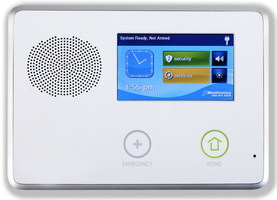
We offers two-way voice as part of our HomeTouch Premier package. Two-way voice capability is dependent on panel type, so existing customers may need a panel upgrade to take advantage of the service.
How It Works
Two-way voice is similar to an intercom but significantly more powerful. It allows customers to communicate directly with monitoring center representatives using a speaker and microphone built into the security system panel. As soon as an alarm reaches our monitoring center, the operator immediately opens the two-way voice channel and begins speaking. The customer hears the representative over the speaker and responds accordingly. The system also allows the operator to continue listening or provide direction until help arrives.
Faster Response Time
The main advantage of two-way voice is faster response time. With a conventional home security system, the operator at our 24-hour monitoring center must call a customer the moment an alarm is triggered, while two-way voice is nearly instantaneous. In some emergencies, that quick response time could mean the difference between safety and an elevated level of danger.
Burglary Deterrence
A home security system is already an excellent way to prevent burglary or home invasion, but two-way voice increases deterrence. For example, a triggered burglary alarm immediately engages the two-way voice system and connects the monitoring center. The operator can warn the intruders that they are being monitored and police are on the way, which could be enough to scare them away.
Two-way voice also allows subscribers to come up with emergency passwords that can alert operators they are being held against their will or threatened by intruders. If the password is spoken, an operator will know that the situation is escalating. That information can be passed on to police dispatchers immediately.
Fire Response
In the event of a house fire, two-way voice enables a homeowner to alert the monitoring center that everyone has escaped safely, with no need to waste time searching for a phone. If occupants are trapped in the house, two-way voice can make it easier to verify their location. The operator can also provide safety advice until the fire department arrives.
These are just some of the benefits of making two-way voice a part of your home security system. We believe two-way voice is one of the most effective features to be added to home security in a long time. Whether your system is wireless or wired, you should consider adding two-way voice to your existing package. Of course, new subscribers would be wise to take advantage of it as well.
We would be more than happy to answer all of your questions about two-way voice and other valuable features of our HomeTouch Premier package. Just give us a call at 717-248-4996 to learn more.
